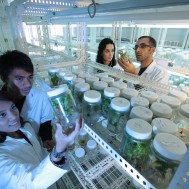Cleanrooms exist without equals from a manufacturer’s perspective: the specificity of the conditions with which cleanrooms are built is ideal for the creation of various consumer products and applications. Simply put, cleanrooms are environments with very particular air quality. The entire process of distinguishing environments based on cleanroom class is rooted in the science that changes in the minutiae of an atmosphere, which can have an effect on product quality.
The filtration and monitration of particulate in the air offer the ultimate conditions to manufacture certain items, such as electronic products and pharmaceuticals, as well as the best environment to conduct scientific research. The numbers that back these filtration and monitration processes are provided by the International Standards Organization (ISO), which functions to impose such standards on research and product development communities worldwide.
The current system for certifying rooms based on cleanroom class is known as ISO 14644. ISO 14644 dictates eight levels, with Level 1 being extremely clean and Level 8 being the least, that make up the standards to certify cleanroom class. A cleanroom is constructed to meet a specific level’s standard of cleanliness. Then, an inspection process is set up to ensure that the room meets the requirements of a given level. Cleanroom class has to be verified in the room as it is, when the room has equipment in it, also known as “at built” and when the room is fully operational with active workers.
In addition to air quality itself, a few other characteristics of physical environment come into play:
1. Temperature
Fluctuation in temperature affects growth on a micro level; new bacteria form at different temperatures.
2. Humidity
Affects the amount of static in the air and enhances temperature effects.
3. Light
Can complement heat effects, and also can be abrasive depending upon the material being manufactured.
4. Sound & Vibration
Sound pressures and vibration amplitudes are two very common interferences that affect the performance of equipment required to maintain a specific cleanroom class standard.
5. Pressure
“Positive” in pressure terms means that the air pressure inside the cleanroom exceeds the outside environment. It’s crucial to place the utmost importance on preventing any sort of contaminants from entering the room. Alternatively, “negative” pressure means that the air pressure within the room is lower than outside air pressure. This is generally used when the environment of the cleanroom should be restricted to the outside world, because in this case, air will flow in rather than flow out.
6. Number of Air Changes per Hour
The more air changes there are in the room, the more the volume of air equivalency within that room increases. As set by ISO, air changes by cleanroom class are monitored on a per hour basis.
7. Air Filtration
Monitoring Prefilter and HEPA filters will assure proper airflow and contamination levels.
For employees whose job requires them to work nearby or within the confines of a particular cleanroom class, there are several precautions taken to ensure that their physical being has no effect on the product. These methods of preventative dress vary in accordance with cleanroom class, and are known on a general level as the “gowning” process. Gowning may include use of a face mask, specific smocks or coveralls, industry-standard boots, shoe covers and garments that contain body hair, like hoods or covers.
At its most basic level, the maintenance of cleanroom class is all about quality: attention paid to details such as air pressure volume and temperature will ultimately affect the makeup of the product being manufactured.
Interested in talking more about cleanrooms or other practices for emphasizing quality in manufacturing?
Tweet us @applerubber and continue the conversation.
